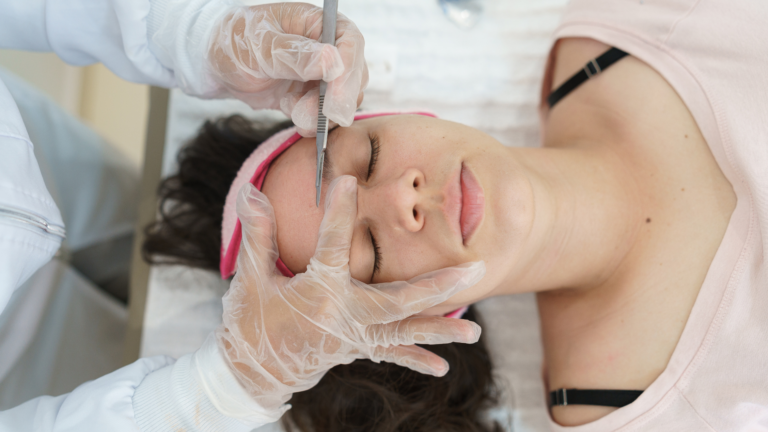Dermaplaning is a popular cosmetic procedure designed to exfoliate the skin and remove fine facial hair using a sterile scalpel. This non-invasive treatment effectively rejuvenates your complexion by gently scraping away dead skin cells and peach fuzz, resulting in smoother, brighter, and more radiant skin. By gently and effectively removing the layer of dead skin cells that accumulates on the skin’s surface over time, dermaplaning reveals the fresher, healthier skin underneath and not only promotes a smoother texture but also imparts a natural radiance to the complexion.
One of the standout advantages of dermaplaning is the enhanced absorption of skincare products; after the procedure, the freshly exposed skin is highly receptive to serums, moisturisers, and other treatments. This heightened absorption ensures that these products penetrate deeper into the skin, where they can be more effective in addressing specific skin concerns such as fine lines, uneven texture, or hyperpigmentation. Another great benefit is makeup now glides on effortlessly and evenly for a smoother, more flawless makeup finish. Many makeup enthusiasts and professionals choose dermaplaning as a pre-makeup treatment to achieve a flawless base for their cosmetic products!
$125

Exfoliation: Dermaplaning effectively removes the top layer of dead skin cells, promoting skin cell turnover. This exfoliation results in a smoother, brighter complexion.
Improved Texture: Dermaplaning can help reduce the appearance of rough skin, acne scars and uneven texture, leaving the skin feeling softer.
Anti-Aging: By exfoliating and stimulating the skin, dermaplaning can minimise the appearance of fine lines and wrinkles.
Brighter Complexion: The removal of dead skin cells and peach fuzz can result in a more radiant complexion as light reflects more evenly off the skin.
Enhanced Product Absorption: After dermaplaning, skincare products are better absorbed by the skin, making them more effective.
Makeup Application: Makeup goes on more smoothly, providing a flawless finish.
No, dermaplaning does not cause stubble. The result is a smoother and hair-free complexion. The hair that is removed through dermaplaning is typically fine and light, and it grows back at the same thickness and texture as before, so there is no risk of it turning into stubble.
The removal of fine facial hair is a key aesthetic benefit of dermaplaning. This hair, often barely noticeable, can affect the way light interacts with the skin, potentially causing it to appear dull. By eliminating this “fuzz,” dermaplaning allows the skin to reflect light more evenly, resulting in a brighter and more vibrant appearance.
Dermaplaning is generally not recommended if you have active, inflamed acne. The procedure could potentially irritate these areas and spread bacteria, making the acne worse. It’s best to wait until the active breakouts have healed before considering dermaplaning.
Dermaplaning is similar to shaving in that both processes involve the removal of hair from the skin’s surface using a sharp blade. However, there are some key differences:
Tool and Technique: Dermaplaning is typically performed by a trained professional using a specialised dermaplaning tool. The practitioner holds the blade at a specific angle and gently scrapes it across the skin to exfoliate and remove fine facial hair. Shaving, on the other hand, often involves a razor and is typically done at home for hair removal without the exfoliation aspect.
Depth of Hair Removal: In dermaplaning, the blade is designed to remove hair at the skin’s surface, while shaving may cut hair slightly below the skin’s surface. This can lead to differences in the way hair regrows after each method.